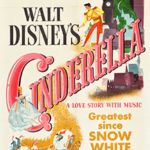 Cinderella, the 12th animated feature from Walt Disney Productions, went into wide release on March 4, 1950. The project was years in the making. As early as 1938, Al Perkins had written an outline for Disney based on Charles Perrault’s fairytale. After numerous drafts, production halted during WWII. In 1947, storyboarding began on the treatment by Ted Sears, Homer Brightman, and Harry Reeves. Ben Sharpsteen was assigned as supervising producer, with Hamilton Luske, Wilfred Jackson, and Clyde Geronimi as sequence directors, and production wrapped in 1949. Below is the original 1950 trailer.
Cinderella, the 12th animated feature from Walt Disney Productions, went into wide release on March 4, 1950. The project was years in the making. As early as 1938, Al Perkins had written an outline for Disney based on Charles Perrault’s fairytale. After numerous drafts, production halted during WWII. In 1947, storyboarding began on the treatment by Ted Sears, Homer Brightman, and Harry Reeves. Ben Sharpsteen was assigned as supervising producer, with Hamilton Luske, Wilfred Jackson, and Clyde Geronimi as sequence directors, and production wrapped in 1949. Below is the original 1950 trailer.
The voice cast included Ilene Woods (Cinderella), Eleanor Audley (stepmother Lady Tremaine), Verna Felton (Fairy Godmother), Rhoda Williams (stepsister Drizella), Lucille Bliss (stepsister Anastasia), James MacDonald (mice Jaq and Gus), Luis van Rooten (King and Grand Duke), Don Barclay (Doorman), William Phipps (Prince Charming, sung by Mike Douglas), Earl Keen (dog Bruno), June Foray (cat Lucifer), and Betty Lou Gerson (Narrator).
The principal animators were Les Clark, Marc Davis, and Eric Larson (Cinderella), Norman Ferguson (King, Grand Duke), Ollie Johnston (stepsisters), Milt Kahl (Godmother, Prince), Ward Kimball (Lucifer, Bruno), John Lounsbery (Jaq, Gus, Lucifer, Bruno), Wolfgang Reitherman (Jaq, Gus), and Frank Thomas (stepmother). Below is the opening main title sequence, underscored by the title song “Cinderella.”
Oliver Wallace composed the score, with Frank Comstock and Joseph Dubin providing the orchestrations, while the songs were written by Mack David, Al Hoffman, and Jerry Livingston — the first composers hired from outside Disney. The six songs performed in the film are “Cinderella” (sung by the Jud Conlon Chorus, featuring Marni Nixon), “A Dream Is a Wish Your Heart Makes” (Ilene Woods), “Sing Sweet Nightingale” (Eleanor Audley, Rhoda Williams, Ilene Woods), “The Work Song” (James MacDonald), “Bibbidi-Bobbidi-Boo” (Verna Felton), and “So This Is Love” (Ilene Woods, Mike Douglas). Below is Oscar nominee “Bibbidi-Bobbidi-Boo.”
The film became the biggest critical and commercial hit for Disney since Snow White (1937), helping to reverse the studio’s ailing fortunes after the war. It earned three Oscar nominations, including those for its sound (C.O. Slyfield), scoring (Wallace, Smith), and song “Bibbidi-Bobbidi-Boo” (David, Livingston, Hoffman). The soundtrack EP, featuring four songs, topped the Billboard charts for two weeks in 1950. Disney rereleased the film in 1957, 1965, 1973, 1981, and 1987 and offered the full soundtrack in 1997.
Cinderella’s castle has become an icon of the company, not only as part of its logo but also as the centerpiece of Walt Disney World’s Magic Kingdom (1971) and Tokyo Disneyland (1983). Then came the direct-to-video sequels Cinderella II: Dreams Come True (2002) and Cinderella III: A Twist in Time (2007) and a 2015 live-action adaptation. In 2018, the Library of Congress selected the film for its National Film Registry. Below is “Bibbidi-Bobbidi-Boo” from the 2015 live-action version.
